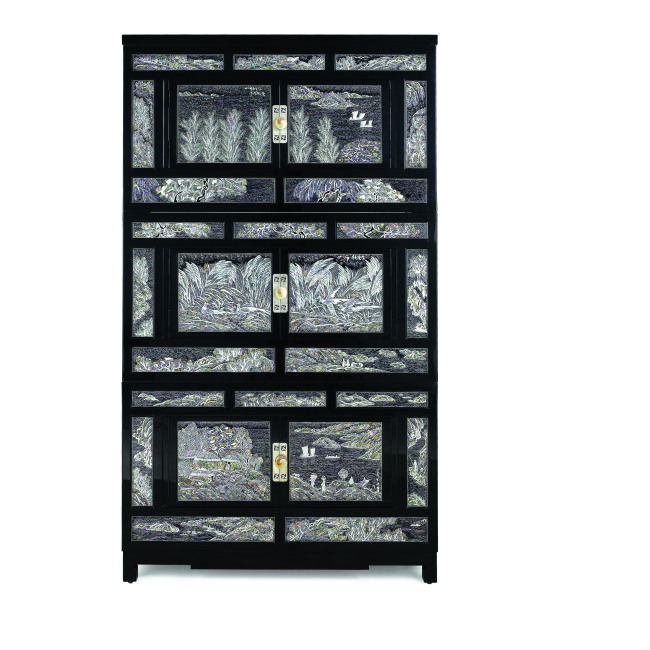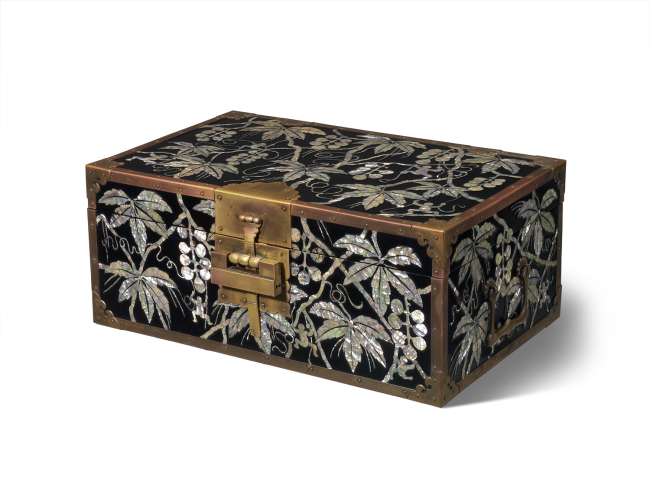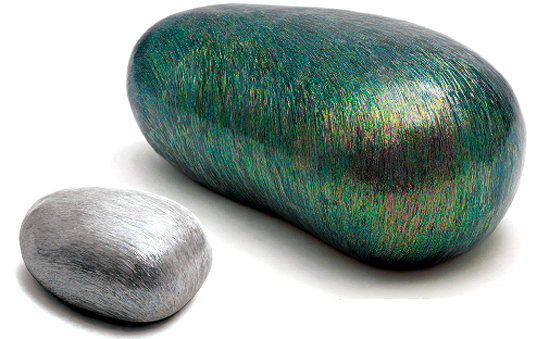At the hill of Mount Namsan, where a sprawling metropolis of 10.5 million starts to give way to a forest of leafy trees, a small museum opened in December.
Nestled inside are wooden chests, tables, jewelry boxes and other intricate craftworks lacquered and decorated with exquisite mother-of-pearl inlays. Everything inside is the private collection of Sohn Hye-won.
“I never thought that I would really do this -- open a museum,” said Sohn, 60, in an interview at the Korea Mother-Of-Pearl Art Museum. “Maybe I am just crazy.”
 |
Lacquered wardrobe inlaid with mother-of-pearl by Lee Sung-woon. (Crosspoint Cultural Foundation) |
To open the museum in this hillside building, she relocated Crosspoint, a top-notch brand design and naming company and her main source of income, to another building just 20 meters down the hill.
“On weekdays, I am mostly at my office, sometimes working 15 hours a day. Then on weekends, I tend to this museum and artisans of najeon chilgi (the Korean traditional craft of lacquerware inlaid with mother-of-pearl)” Sohn said.
At Crosspoint, she is the epitome of success.
 |
Lacquered box inlaid with mother-of-pearl by Kim Bong-ryong (1902~1994). (Crosspoint Cultural Foundation) |
Fiercely independent, confident and determined to continue her winning streak, she leads a team of the industry’s top-notch designers and branding experts in the money-spinning market world.
Many of her creations are household names now, such as “Dimchae” kimchi refrigerators, “Tromm” washing machines, “Xcanvas” TV sets, “Hillstate” apartments and “Chum Churum” soju.
The hefty bonuses and fat paychecks from these creations go into her ‘crazy’ other profession. In the world of najeon chilgi, money seems to flow in only one direction -- out of her pocket.
Artisans who she thinks so highly of lack the basic means to continue their trade because there is no market for their works.
But she said she can’t just sit idle and watch them give up on their time-honored trade, so she plays every role that she can -- patron, collector, exhibition curator, publisher, publicist and marketer.
“I’m in two completely different worlds. The gap is so wide that sometimes I find myself wondering ‘what on earth am I doing here?’”
Hearing her speak, one has to wonder what it is about mother-of-pearl art that she admires so much. Love?
“No. It’s not love,” Sohn quickly answered.
What’s driving her is, ironically, the same part of her that brought her success in the field of brand name development, she said.
 |
Pebbles by Hwang Sam-yong (Crosspoint Cultural Foundation) |
“As a naming expert, I am trained to see the core value of objects. I am also trained to sense what the mass desires,” she said. “All of my senses tell me that najeon chilgi will take off globally.”
The artistry and sophistication of mother-of-pearl art in Korea is unrivalled in the world, she continued.
The craft of pasting the inner lining of the abalone onto woodenware using lacquer originated in China, but it flourished here during the Goryeo Dynasty (918-1392).
The traditional craft, however, has lost ground and is now at the brink of dying out as Koreans have quickly developed a taste for Western designs. Sohn also felt the same until just eight years ago.
“I am trained in modern designs and I have loved foreign brands. The past me wouldn’t even think of wearing hanbok like this one,” she said, pointing at her overcoat inspired by the traditional Korean costume.
Sohn’s first encounter with the traditional art of najeon chilgi dates back to 2006 in the southern port city of Tongyeong where she was developing a logo for the city government.
She met Song Bang-ung, a master artisan based in the city, and ended up buying several of his works. Since then, she has collected over 300 najeon chilgi items, pouring nearly 5 billion won ($5.4 million) into the art.
“In najeon chilgi, I saw what can be the representative art of Korea. But, obviously, no one other than me must have seen it, because it was dying,” she said.
In 2012, she set up Highhand, which sells high-quality but reasonably priced najeon chilgi items with modern designs. It was a move intended at cultivating the market, but also to preserve the craft for future generations.
 |
Sohn Hye-won, director of the Korea Mother-Of-Pearl Art Museum and CEO of brand designing and naming firm Crosspoint, smiles at one of her museum’s exhibition rooms at the foot of Mount Namsan, Seoul.(Lee Sang-sub/The Korea Herald) |
In 2013-2014, as an artistic director she organized “Constancy and Change in Korean Traditional Craft” during an international furniture fair in Milan, Italy.
The two overseas exhibitions were a spectacular success, Sohn said, and convinced her that she was right about najeon chilgi.
“The British Museum and the Victoria and Albert Museum in London bought some of the works that I selected and curated. That really meant a lot for me,” she said.
Going forward, Sohn wants to commit herself to the overseas promotion of najeon chilgi, starting right here at her hillside museum.
Currently, it is holding an exhibition of 33 najeon chilgi artists from the 19th century up until now.
“It is going to be shown at four countries this year,” she said.
“I believe in this (najeon chilgi) and I am happy to be doing this. I am doing the right thing then, right?”
By Lee Sun-young(
milaya@heraldcorp.com)











